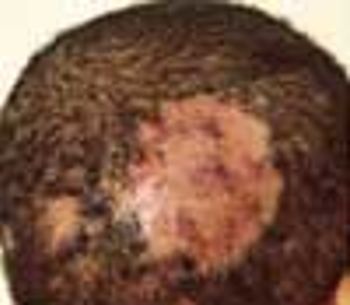
This is a common infectious problem, especially among school-age children. In many cases, there are well-defined areas of hair loss that can mimic alopecia areata.


This is a common infectious problem, especially among school-age children. In many cases, there are well-defined areas of hair loss that can mimic alopecia areata.
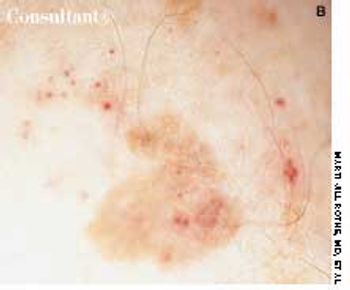
A 69-year-old man with a history of basal cell carcinoma of the face and back presented for a 6-month skin cancer evaluation. Physical examination revealed an asymmetric, irregularly pigmented, thin brown plaque of the anterior chest. A 3-mm punch biopsy specimen was obtained from a deeply pigmented area at the inferior border of the lesion to rule out melanoma.

A scaling, red, fissured area between digits 4 and 5 on her right hand sent a 33-year-old woman to her physician. Diagnosis of interdigital Candida was confirmed by a potassium hydroxide evaluation of material from the site.
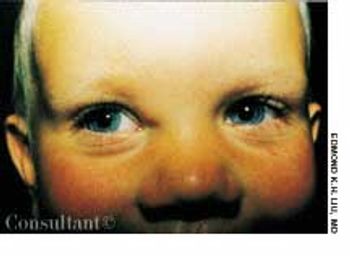
The parents of a 2-year-old boy were curious about the “bump” near their son's eye, which they had first noticed about 6 months earlier. The cystic mass in the right medial canthal region measured 8 mm in diameter. It was nontender.
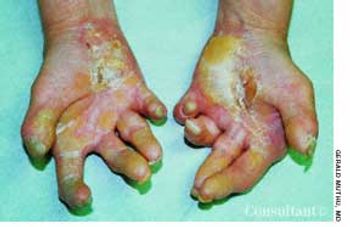
A 40-year-old woman presented for follow-up of a generalized skin condition that was most severe on her palms and soles. She had been born with a few lesions, which resolved in infancy. New lesions began to emerge and increase in number and severity when she was 2 years old; they have recurred intermittently for 38 years.
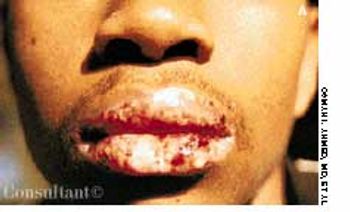
Erythromycin had been prescribed for a 15-year-old boy who complained of flulike symptoms. Twenty-four hours after starting the medication, he awakened with painful ulceration of his mouth and lips. The erythromycin was discontinued, and hydroxyzine (25 mg, three times daily) was started for possible macrolide sensitivity. His condition worsened over the next 3 days, however, and he was hospitalized when the severe oral pain made it impossible for him to tolerate food or drink. At no point had he any nausea, vomiting, diarrhea, fever, or chills.

This lesion on her knee had been present for 5 years, reported a 22-year-old woman. It was not related to any trauma, and its size had not changed, but occasionally it became darker or lighter.

Gonococcal infection is the leading cause of bacterial arthritis in adults.
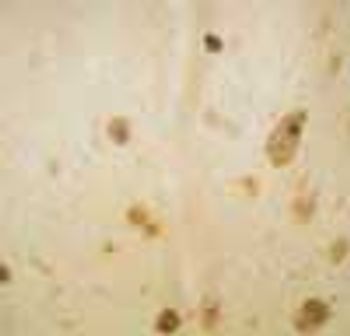
A 75-year-old man complained of the sudden appearance of multiple “moles” on his back. He had no history of skin cancer. Past medical history was significant for prostate cancer, which had been diagnosed and treated 2 years previously.

Mongolian spots are congenital, hyperpigmented, usually gray areas of varying size and shape. They result from the abnormal occurrence of melanocytes in the lower half of the dermis and are found most frequently in the sacrococcygeal and gluteal areas.
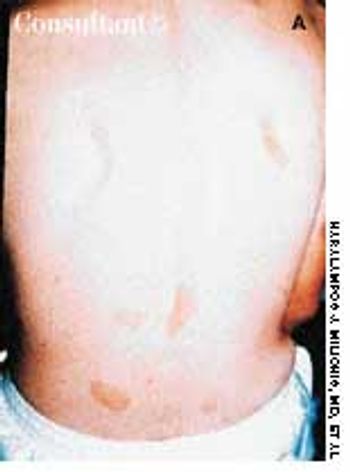
A 19-year-old man was referred for further investigation of multiple pigmented cutaneous lesions.
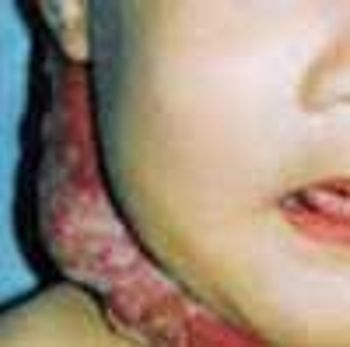
These collections of dilated vessels deep in the dermis and subcutaneous tissue are present at birth. They usually present as bluish or reddish lesions that are cystic, firm, and compressible. About 60% to 80% of cavernous hemangiomas undergo spontaneous involution, often with central clearing and fibrosis.
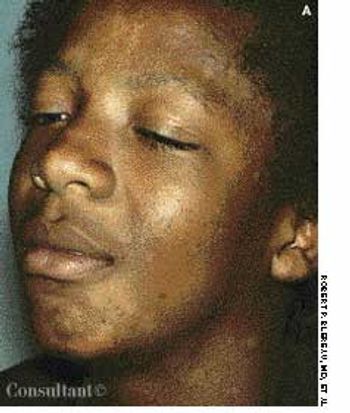
Although tinea versicolor is fairly common, its appearance on the face and neck is unusual, notes Robert P. Blereau, MD of Morgan City, La. His patient, a 30-year-old woman, exhibits the pale, rounded, fine-scaled lesions typically found on tanned or dark-skinned persons.
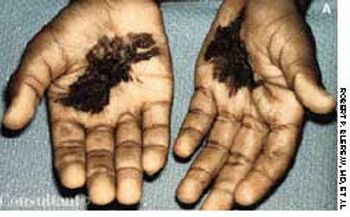
During a routine physical examination of a healthy 7-year-old African-American boy, this striking-and puzzling-hyperpigmentation was noted on his palms.
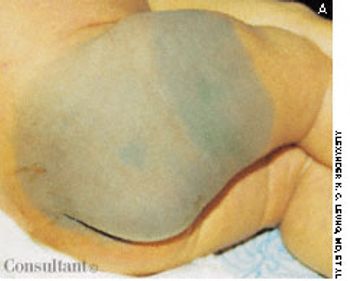
These are hyperpigmented, regularly bordered, sharply demarcated macules that are usually tan or light brown in whites and dark brown in dark-skinned persons. The lesions are characterized by an increased number of melanocytes and an increased amount of melanin in the epidermis.
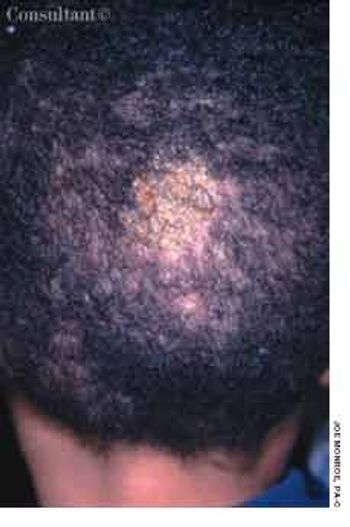
A 6-year-old African American boy is referred for evaluation of “cellulitis,” which had persisted for several weeks. The condition had failed to respond to oral antibiotics prescribed by another practitioner.

A 58-year-old man presented with a 6-month history of a mildly pruritic rash of the left axilla. The patient was in good health, took no medications, and denied any other symptoms.
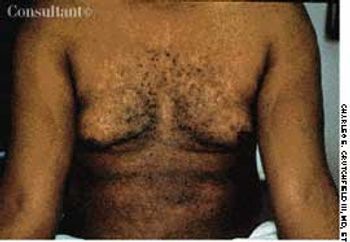
The sharp transitions in pigmentation on the anterior surface of the arms of this 49-year-old black man were noted as an incidental finding. The arms' lateral aspects were distinctly more deeply pigmented than the medial aspects. In addition, a hyperpigmented band was present over each pectoral area, while a hypopigmented vertical stripe covered the sternum. These symmetric transitions in pigmentation are normal variants found most commonly in blacks and are known as pigmentary demarcation lines.
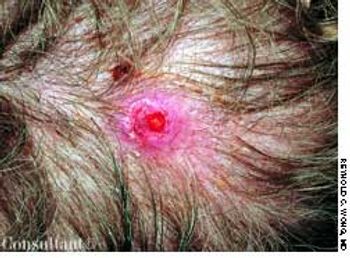
A red papule developed on the scalp of a 52-year-old man who had a history of adenocarcinoma of the lungs. The patient was a former cigarette smoker.
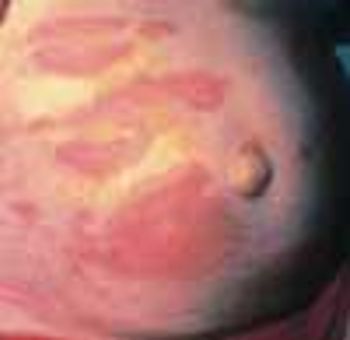
Some cutaneous conditions are unique to pregnancy and the postpartum period. Others may affect both pregnant and nonpregnant women. Familiarity with these conditions is important in the evaluation of a pregnant patient with a rash or cutaneous lesion.

An acute exacerbation of asthma brought this 52-year-old Russian emigré to the emergency department (ED). Examination revealed the well-demarcated round erythema and ecchymosis on the patient's back. This circular pattern was created by cupping performed 2 days earlier by the patient's wife in an effort to treat her husband's asthma.
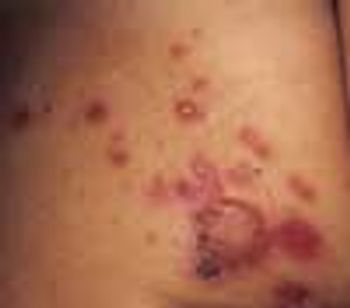
The numerous superficial, rounded, red-based ulcerations on the left buttock of a 3-year-old girl are characteristic of bullous impetigo. The varnish-like crust on the largest lesion is also typical of this skin infection.
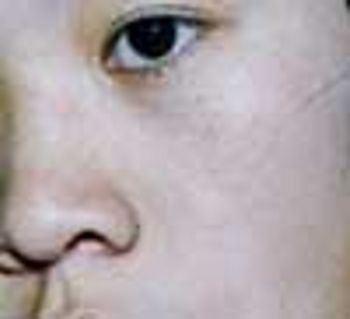
The nonpruritic hypopigmented lesions on this 13-year-old girl's cheeks are characteristic of pityriasis alba, which typically occurs in children of both sexes between the ages of 3 and 16 years.
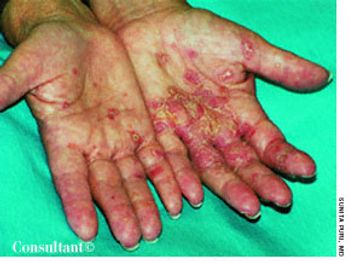
A rash on both palms concerned a 35-year-old hairdresser, who said she always wears vinyl gloves while working. She recalled using a new hair coloring product on a client a few days earlier. Within 24 hours of applying the substance, the rash began to erupt; it worsened over the course of 2 days.
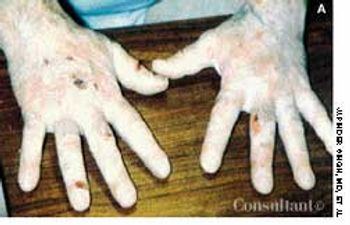
A 50-year-old man with a history of diabetes, hypertension, seizure disorder, and alcohol abuse sought treatment for a rash and painful ulcerations of the hand, face, and scalp, which had bothered him for 1 month. The patient also complained of pruritus.